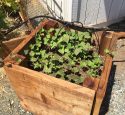What can be more Irish than the potato? Irish recipes for potato dishes are seemingly endless. Along with the shamrock, they are the first thing that comes to mind when we think of Ireland. But are they really Irish? Actually, no. The Incas of ancient Peru were the first people to cultivate the potato 8,000 years BCE. It is thought that the word potato comes from the Quechua word, “papa,” and the Indian word, “batata”. The Incas revered potatoes so much that they buried them with their dead. In 1532 the Spanish conquistadors brought them on their ships returning to Europe to prevent Scurvy because they are rich in vitamin C. Potato crops flourished in the European climate. In 1589 Sir Walter Raleigh introduced them to Ireland by planting them on 40,000 acres of land near County Cork.
Potatoes are so rich in nutrients that they sustained the whole population of Ireland for over 300 years, until a blight swept through Europe and wiped out most of the potato crops in 1840. The Irish working class was hit hardest. One million people died of famine and another million emigrated to the United States and Canada. The blight (fungus) attacked both the leaves and the tubers and the crops failed for five years in a row.
Potatoes contain more potassium than a banana and are a good source of vitamin B6, C and magnesium. They are fat and cholesterol-free and contain fiber and iron. The potato is from the nightshade family – similar to tomatoes – and only the fruit is edible. The leaves, like the leaves of the tomato plant contain the toxin solanine and are not fit to eat. Potatoes that have been stored improperly (exposed to light) produce glycoalkaloids – green skins that are detrimental to human health. They should be stored in a cool, dark place.
There are close to 4,000 varieties of potatoes. They are herbaceous plants that grow 24 inches high. Bumblebees cross-pollinate them, though some self-fertilization occurs as well. Most of the potatoes that are grown in the United States came from Europe with the settlers, not from South America.
Potatoes are easy to grow and should be planted in early spring, when the ground temperature reaches 45F. There are five phases of growth. First sprouts appear; next photosynthesis begins; the plant then develops stolons (a horizontal branch at the base of the plant) on the surface of the soil. On these stolons the tubers develop as swellings. Formation of tubers stops when the temperature reaches 81F, so they are a spring crop.
To plant potatoes first dig trenches six to eight inches deep. The trenches should be spaced between twelve and fifteen inches apart. Plant each piece of potato with the cut side down and the eyes pointing up. Fill in the trenches with only four inches of soil. As the plants grow, continue filling in the soil.
Keep the potato vines well-watered throughout the growing period, especially when flowering occurs and immediately after. They need one to two inches of water each week. When the plant
finishes flowering and the leaves turn yellow, you should discontinue watering. This will cure the potatoes for the harvest.
Harvest the potatoes two to three weeks after they have finished dying back. Let them lie in the field – unwashed – for 3 or 4 days. This allows the skins to toughen so they will store better. They should be stored in a dark, cool, well-ventilated place between 35 and 40F.
Although the potato isn’t really Irish, it has become Irish by association. So, this St. Patrick’s Day, if you are serving food, make sure you include potatoes as one of the dishes. Some people use food coloring to make them green for the occasion. Happy St. Patrick’s Day. Erin Go Bragh! (which means Ireland forever – Éirinn go Brách in Irish).
Francie McGowan is a University of California Cooperative Extension Master Gardener of Tuolumne County.
UCCE Master Gardeners of Tuolumne and Calaveras Counties can answer home gardening questions. Call 209-533-5912 or go to: http://ucanr.edu/survey/survey.cfm?surveynumber=7269 to fill out our easy-to-use problem questionnaire. Check out our website at: http://cecentralsierra.ucanr.edu/Master_Gardeners/ You can also find us on Facebook.


